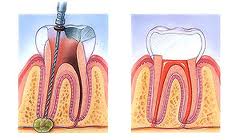Two of my left molar teeth are infected. Both teeth have old fillings in them. After over a month of pain that I managed with Advil, I went to the dentist. The dentist took an x-ray and said both teeth have an abscess, and he wants to extract them both. I asked him about my options, and he said there aren’t any. Is this a standard solution for molar teeth with abscesses? – Thank you. Noah from Austin
Noah,
A dentist is ethically and legally obligated to explain your options. Unless your dental insurance is government funded, your dentist must explain your options. Government programs will pay for the cheapest option, which is extraction.
Treatment Alternatives to Tooth Extraction
If your teeth are infected, root canal treatment is the best treatment option. An abscess at a tooth root is a sign that the tooth pulp—living tissue—is dead. Tooth nerves are in the pulp, so your root canal treatment will be painless and more comfortable than tooth extraction. When third molars, or wisdom teeth, are infected, tooth extraction is best because wisdom tooth anatomy is complex.
Faulty Fillings and Tooth Pain
Faulty fillings can cause tooth pain and lead to infection. If your dentist did shoddy work on your fillings and knows it, he may want to extract your teeth without explaining your option.
What Happens After Tooth Extraction?
If a dentist extracts a second or first molar, the upper tooth will probably drift into the space and hit the lower gum. You can lose the upper tooth also. If there are no teeth behind your second molar, you probably won’t have complications.
Keep in mind that Dr. Lacy has not examined your teeth, and we cannot provide an accurate diagnosis. We recommend that you get a second opinion from an experienced dentist who will explain your treatment options. It would be unusual, but if you require extractions and dental implants, you can speak with the dentist about financing or payment plans if needed.
This post is sponsored by Plano, TX female dentist Dr. Miranda Lacy.


